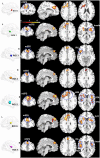Disrupted Brain Entropy And Functional Connectivity Patterns Of Thalamic Subregions In Major Depressive Disorder
- PMID: 31571880
- PMCID: PMC6750201
- DOI: 10.2147/NDT.S220743
Disrupted Brain Entropy And Functional Connectivity Patterns Of Thalamic Subregions In Major Depressive Disorder
Abstract
Purpose: Entropy analysis of resting-state functional magnetic resonance imaging (R-fMRI) has recently been adopted to characterize brain temporal dynamics in some neuropsychological or psychiatric diseases. Thalamus-related dysfunction might be a potential trait marker of major depressive disorder (MDD), but the abnormal changes in the thalamus based on R-fMRI are still unclear from the perspective of brain temporal dynamics. The aim of this study was to identify local entropy changes and subregional connectivity patterns of the thalamus in MDD patients.
Patients and methods: We measured the sample entropy of the R-fMRI data from 46 MDD patients and 32 matched healthy controls. We employed the Louvain method for the module detection algorithm to automatically identify a functional parcellation of the thalamus and then examined the whole-brain subregional connectivity patterns.
Results: The results indicated that the MDD patients had decreased entropy in the bilateral thalami compared with healthy controls. Increased functional connectivity between the thalamic subregions and the medial part of the superior frontal gyrus (mSFG) was found in MDD patients.
Conclusion: This study showed new evidence about sample entropy changes in MDD patients. The functional connectivity alterations that were widely distributed across almost all the thalamic subregions with the mSFG in MDD suggest a general involvement independent of the location and function of the subregions.
Keywords: entropy; functional connectivity; major depressive disorder; superior frontal gyrus; thalamus.
© 2019 Xue et al.
Conflict of interest statement
The authors report no conflicts of interest in relation to this work.
Figures





Similar articles
-
Abnormal dynamic functional connectivity of thalamic subregions in patients with first-episode, drug-naïve major depressive disorder.Front Psychiatry. 2023 May 10;14:1152332. doi: 10.3389/fpsyt.2023.1152332. eCollection 2023. Front Psychiatry. 2023. PMID: 37234210 Free PMC article.
-
Functional connectivity between the thalamus and the primary somatosensory cortex in major depressive disorder: a resting-state fMRI study.BMC Psychiatry. 2018 Oct 19;18(1):339. doi: 10.1186/s12888-018-1913-6. BMC Psychiatry. 2018. PMID: 30340472 Free PMC article.
-
The role of the thalamic subregions in major depressive disorder with childhood maltreatment: Evidences from dynamic and static functional connectivity.J Affect Disord. 2024 Feb 15;347:237-248. doi: 10.1016/j.jad.2023.11.074. Epub 2023 Nov 23. J Affect Disord. 2024. PMID: 38000476
-
Disrupted functional connectivity patterns of the insula subregions in drug-free major depressive disorder.J Affect Disord. 2018 Jul;234:297-304. doi: 10.1016/j.jad.2017.12.033. Epub 2017 Dec 28. J Affect Disord. 2018. PMID: 29587165
-
Abnormal dynamic functional connectivity of amygdalar subregions in untreated patients with first-episode major depressive disorder.J Psychiatry Neurosci. 2018 Jul;43(4):262-272. doi: 10.1503/jpn.170112. J Psychiatry Neurosci. 2018. PMID: 29947609 Free PMC article.
Cited by
-
Default Mode Network Modulation by Psychedelics: A Systematic Review.Int J Neuropsychopharmacol. 2023 Mar 22;26(3):155-188. doi: 10.1093/ijnp/pyac074. Int J Neuropsychopharmacol. 2023. PMID: 36272145 Free PMC article.
-
Individualized diagnosis of major depressive disorder via multivariate pattern analysis of thalamic sMRI features.BMC Psychiatry. 2021 Aug 20;21(1):415. doi: 10.1186/s12888-021-03414-9. BMC Psychiatry. 2021. PMID: 34416848 Free PMC article.
-
Abnormal dynamic functional connectivity of thalamic subregions in patients with first-episode, drug-naïve major depressive disorder.Front Psychiatry. 2023 May 10;14:1152332. doi: 10.3389/fpsyt.2023.1152332. eCollection 2023. Front Psychiatry. 2023. PMID: 37234210 Free PMC article.
-
The different impacts of functional network centrality and connectivity on the complexity of brain signals in healthy control and first-episode drug-naïve patients with major depressive disorder.Brain Imaging Behav. 2025 Feb;19(1):111-123. doi: 10.1007/s11682-024-00923-5. Epub 2024 Nov 13. Brain Imaging Behav. 2025. PMID: 39532824
-
Aberrant dynamic functional connectivity of thalamocortical circuitry in major depressive disorder.J Zhejiang Univ Sci B. 2024 Feb 24;25(10):857-877. doi: 10.1631/jzus.B2300401. J Zhejiang Univ Sci B. 2024. PMID: 39420522 Free PMC article.
References
-
- Richards CS, O’Hara MW. The Oxford Handbook of Depression and Comorbidity. Oxford University Press; 2014:254.
LinkOut - more resources
Full Text Sources
Other Literature Sources

